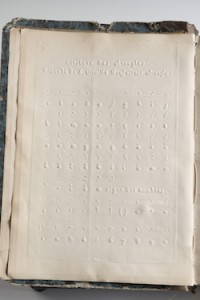M. de Genoude, Evangelie Selon Saint Matthieu (Paris, 1868). Braille type. Dimensions: 380 x 540 x 60mm (open)
RNIB Collection Acc No: L1/7.
This Bible is an early example of braille. Louis Braille (1809-52), a pupil of the Royal Institution for the Young Blind in Paris, had converted an early military code of “night writing” into a raised alphabetic system between 1821-37 comprising of cells in which six raised dots were variously arranged, as well as logographs (single characters that represent whole words) and contracted forms. Adopted by the Parisian Institution, braille text had been exhibited at the Great Exhibition, 1851. Benefiting from the Institution’s printing resources which also enabled embossing on both sides of paper, it became popular in France throughout the 1850s-60s, but had limited success initially in Britain.
Object Description:
This book is open on the frontispiece. The left hand page features an alphabetic code for braille characters. There is a line of raised, Roman writing at the top of the page which reads ‘Ecriture des Aveugles [New line] Procédé de L. Braille Professeur Aveugle’. The code consists of 14 lines, alternating raised braille characters with raised Roman alphabet characters, including the 26 letters of the alphabet and accented French characters: grammatical signs and numbers. The braille lines are arranged on the top line, above their corresponding Roman alphabet character. The right hand page consists of embossed braille text. It reads: ‘évangle [new line] selon [new line] saint matthieu [new line] traduction novella [new line] par [new line] m’ de genoude [new line] ouvue et corrígée [new line] paris [new line] imprimerie [new line] de l’institution impériale [new line] des jeunes aveugles [new line] procédé l. braille [new line] 1868.
